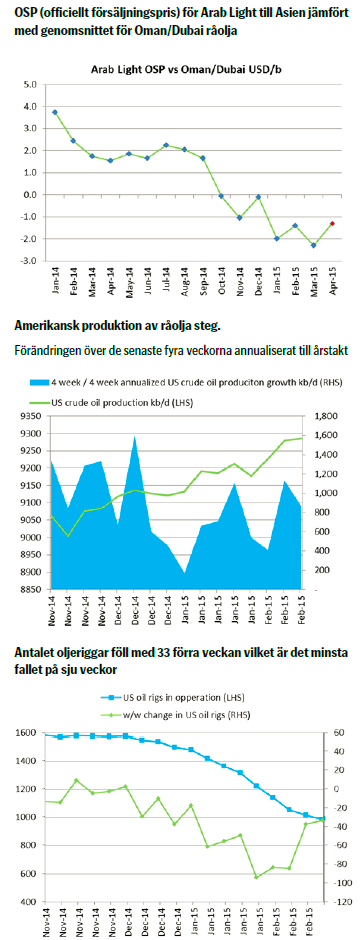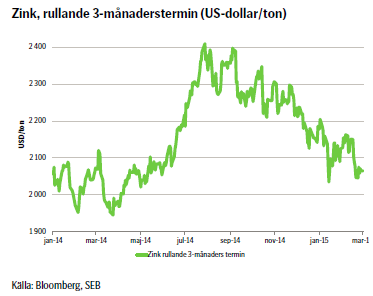Analys
SEB – Råvarukommentarer, 4 mars 2015

Fortsatt full fart framåt
MARKNADEN I KORTHET
 Temat från förra veckans Råvarubrev med full fart fortsätter. Olika marknader går i olika takt och olika data för samma land kan säga olika saker. Ett exempel är Sverige, där förra veckans BNP-siffra överraskade positivt: Förändringen årsvis var 2,8 procent, jämfört med marknadens konsensus om 1,5 procent. Riksbankens stödköpsprogram fortsätter denna vecka, men senast i morse konstaterade Ingves att Sveriges ekonomi är i en ”extremt ovanlig” situation. Vi ser oväntat stark BNP-tillväxt och låg inflation som riskerar att pressas ytterligare nedåt i och med att valutan stärks.
Temat från förra veckans Råvarubrev med full fart fortsätter. Olika marknader går i olika takt och olika data för samma land kan säga olika saker. Ett exempel är Sverige, där förra veckans BNP-siffra överraskade positivt: Förändringen årsvis var 2,8 procent, jämfört med marknadens konsensus om 1,5 procent. Riksbankens stödköpsprogram fortsätter denna vecka, men senast i morse konstaterade Ingves att Sveriges ekonomi är i en ”extremt ovanlig” situation. Vi ser oväntat stark BNP-tillväxt och låg inflation som riskerar att pressas ytterligare nedåt i och med att valutan stärks.
Ett annat land som ständigt är i fokus är Kina och den senaste tidens data är tämligen likriktade. PMI kom för andra månaden i rad in på under 50 som, även om siffran var bättre än förväntat, i sig betyder att ekonomin är i kontraktionsfas. Samtidigt kom beskedet att Kinas centralbank sänkte räntan för att stimulera ekonomin, men enligt data från Bloomberg fortsätter trenden med i genomsnitt sjunkande priser på nybyggda hem i 70 kinesiska städer. Implikationerna är förstås flera, men den uppenbara tolkningen är att ekonomin saktar in. Som världens största importör av guld får det naturligtvis påverkan på guldpriset – se avsnittet nedan.
Brentoljan stängde på sin årshögsta veckostängningsnotering i fredags och den höga volatiliteten fortsätter. Som vi tidigare har beskrivit är effekterna av det låga oljepriset tudelade – det slår mot vissa delar av ekonomin samtidigt som andra gynnas. Länder som kämpar med låg inflation och är stora importörer av olja, exempelvis Japan, är uppenbart missgynnade då situationen innebär ett ytterligare tryck nedåt på inflationen.
Förra veckans uppgång i oljepriset i kombination med positiva makrofaktorer fick priserna på basmetaller att börja stiga under samma period. Det kinesiska nyåret är snart slut och marknaden förväntar sig en ökad aktivitet efteråt. Läs mer i kommentaren nedan!
TRENDER I SAMMANDRAG
- Fortsatt geopolitisk oro i världen
- Kina minskar import av guld
- Tecken på ökad global efterfrågan på olja
- Antalet amerikanska oljeriggar fortsätter att minska, men i fallande takt
- Nordisk el fortsatt sidledes rörelse med möjligheter för den aktiva investeraren
REKOMMENDATIONER
En placering i certifikat och warranter är förknippat med risker. Du kan förlora hela ditt investerade kapital. Läs mer om riskerna i SEB:s offentliggjorda Grundprospekt för certifikat- och warrantprogram på seb.se/cert eller seb.se/mini.
OLJA
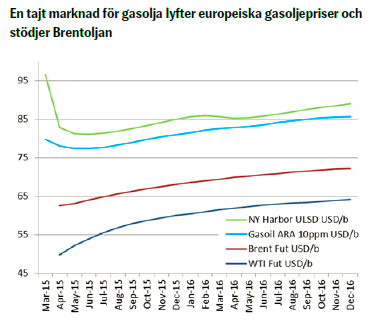 Brentoljan steg med 3,9 procent i förra veckan då priset hoppade upp med 4,2 procent på fredagen och stängde på 62,58 US-dollar/fat. Det innebar således en veckostängning på årshögsta. Prisökningen i Brentoljan kom trots en 1,1 procent ökning i USD-index. Brentoljan fick skjuts av en tajt marknad för gasoljeprodukter i USA och det spiller över i den globala marknaden med kraftig backwardation i amerikanska gasoljeterminer som driver upp gasoljepriser även i Europa. En andra faktor som påverkade priset positivt är tecken på ökad efterfrågan globalt. Detta kan utläsas av Kinas inköpschefsindex (publicerat av HSBC) som kom ut bättre än väntat, Energy Aspects som såg 2,2 procents tillväxt i efterfrågan på olja mätt årsvis i december, Saudiarabien som uttalar sig angående bättre efterfrågan samt IEA:s chefsekonom Fatih Birol som kommenterar att oljemarknaden kommer att stabilisera sig under de kommande månaderna. Hårda data avseende en starkare efterfrågan är dock svåra att hitta, då vi tvärtom exempelvis ser japansk import av råolja ner 8,3 procent i årstakt i december och ner 12,8 procent i årstakt i januari. Om Saudiarabiens utlåtande om ökad efterfrågan är sanna borde vi se en justering uppåt i Saudiarabiens officiella försäljningspris (OSP) för april vilket förväntas enligt en undersökning som nyligen publicerades av Reuters.
Brentoljan steg med 3,9 procent i förra veckan då priset hoppade upp med 4,2 procent på fredagen och stängde på 62,58 US-dollar/fat. Det innebar således en veckostängning på årshögsta. Prisökningen i Brentoljan kom trots en 1,1 procent ökning i USD-index. Brentoljan fick skjuts av en tajt marknad för gasoljeprodukter i USA och det spiller över i den globala marknaden med kraftig backwardation i amerikanska gasoljeterminer som driver upp gasoljepriser även i Europa. En andra faktor som påverkade priset positivt är tecken på ökad efterfrågan globalt. Detta kan utläsas av Kinas inköpschefsindex (publicerat av HSBC) som kom ut bättre än väntat, Energy Aspects som såg 2,2 procents tillväxt i efterfrågan på olja mätt årsvis i december, Saudiarabien som uttalar sig angående bättre efterfrågan samt IEA:s chefsekonom Fatih Birol som kommenterar att oljemarknaden kommer att stabilisera sig under de kommande månaderna. Hårda data avseende en starkare efterfrågan är dock svåra att hitta, då vi tvärtom exempelvis ser japansk import av råolja ner 8,3 procent i årstakt i december och ner 12,8 procent i årstakt i januari. Om Saudiarabiens utlåtande om ökad efterfrågan är sanna borde vi se en justering uppåt i Saudiarabiens officiella försäljningspris (OSP) för april vilket förväntas enligt en undersökning som nyligen publicerades av Reuters.
REKOMMENDATION
- Förra veckans rekommendation i BEAR OLJA X5 B S gick tyvärr med förlust, och vi går ur den positionen. För den kommande veckan är vi neutrala.
GULD
Förra veckan valde vi att gå ur vår kortposition i guld vilket visade sig vara ett klokt beslut. Trots ett starkare dollarindex steg guldpriset i dollartermer cirka 1,6 procent. För kommande vecka ser vi inga tydliga signaler för ett högre guldpris. Förväntningarna att FED kommer att höja styrräntan i år stärktes då statistik visade att amerikansk inflation hamnade under nollstrecket för januari månad. Detta har inte skett sedan oktober 2009. Amerikanska konsumentpriser steg vilket också spädde på förväntningarna om en räntehöjning. En räntehöjning från den amerikanska centralbankens sida skulle innebära en ökad alternativkostnad för att hålla guld.
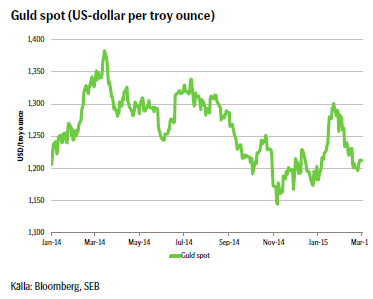 I lördags annonserade den kinesiska centralbanken att man återigen sänker räntan i ett försök att stimulera ekonomin. Problemen i Kina är främst kopplade till en svag utveckling på husmarknaden där priserna på bostäder visar tecken på en accelererande nedgång i många av Kinas större städer. Enligt en sammanställning av Bloomberg föll priset på nybyggda bostäder i 64 av de 70 största städerna i januari. Samtidigt är inflationen fortsatt låg och det finns en ökande oro för att priserna till och med kan komma att falla. Kina, som är världens största importör av guld, såg en minskning av importen av guld vilken föll till den lägsta nivån på fem månader. Eurozonens finansministrar fortsätter diskussionerna med Greklands regering vilken öppnat upp för eftergifter. En sista minuten-lösning och Grekland kvar i eurozonen kommer att dämpa intresset för guld. Generellt har vi emellertid inte sett någon större påverkan på guldpriset av oron i Grekland.
I lördags annonserade den kinesiska centralbanken att man återigen sänker räntan i ett försök att stimulera ekonomin. Problemen i Kina är främst kopplade till en svag utveckling på husmarknaden där priserna på bostäder visar tecken på en accelererande nedgång i många av Kinas större städer. Enligt en sammanställning av Bloomberg föll priset på nybyggda bostäder i 64 av de 70 största städerna i januari. Samtidigt är inflationen fortsatt låg och det finns en ökande oro för att priserna till och med kan komma att falla. Kina, som är världens största importör av guld, såg en minskning av importen av guld vilken föll till den lägsta nivån på fem månader. Eurozonens finansministrar fortsätter diskussionerna med Greklands regering vilken öppnat upp för eftergifter. En sista minuten-lösning och Grekland kvar i eurozonen kommer att dämpa intresset för guld. Generellt har vi emellertid inte sett någon större påverkan på guldpriset av oron i Grekland.
TREND
- Kina minskar sin import av guld och generellt har vi emellertid inte sett någon större påverkan på guldpriset av oron i Grekland.
- En räntehöjning från den amerikanska centralbankens sida skulle innebära en ökad alternativkostnad för att hålla guld.
REKOMMENDATION
- Short Guld D S rekommenderas på 1 till 2 månader.
BASMETALLER
Aluminium & Zink
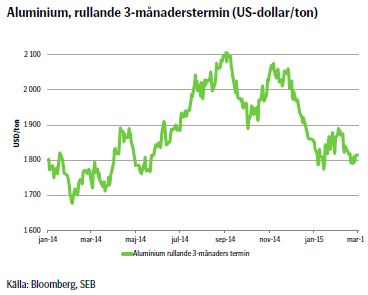 Förra veckan inleddes trevande med allmän avvaktan inför att kineserna återgår till arbetet efter en veckolång ledighet. Förlängningen av Greklands stödprogram, en något ”mjukare” Yellen i sitt tal inför kongressen samt ett stigande oljepris, räckte för att metallpriserna skulle börja röra sig uppåt. Onsdag och torsdag steg priserna på bred front. Fredagen bjöd dock på motstånd, främst beroende av den fortsatt starka dollarn. Den något motsägelsefulla effekten gjorde sig gällande, där dollarkomponenten tar ut den positiva effekten av starka amerikanska konjunktursiffor. Innevarande vecka har börjat på samma tema. Förväntan om ökad industriell aktivitet i Kina efter nyåret kvarstår, men marknadens aktörer är avvaktande. Priserna på aluminium och zink har varit svagt fallande under perioden. Ur ett tekniskt perspektiv har zinkpriset fallit till stödnivån 2050 US-dollar/ton. Aluminium har i skrivandes stund brutit under stödet vid 1800 US-dollar/ton, vilket öppnar upp för en ytterligare potentiell nedgång mot ca 1750 US-dollar. Vår rekommendation på metallerna är på 3-6 månaders sikt och vi begränsar oss till certifikat utan hävstång.
Förra veckan inleddes trevande med allmän avvaktan inför att kineserna återgår till arbetet efter en veckolång ledighet. Förlängningen av Greklands stödprogram, en något ”mjukare” Yellen i sitt tal inför kongressen samt ett stigande oljepris, räckte för att metallpriserna skulle börja röra sig uppåt. Onsdag och torsdag steg priserna på bred front. Fredagen bjöd dock på motstånd, främst beroende av den fortsatt starka dollarn. Den något motsägelsefulla effekten gjorde sig gällande, där dollarkomponenten tar ut den positiva effekten av starka amerikanska konjunktursiffor. Innevarande vecka har börjat på samma tema. Förväntan om ökad industriell aktivitet i Kina efter nyåret kvarstår, men marknadens aktörer är avvaktande. Priserna på aluminium och zink har varit svagt fallande under perioden. Ur ett tekniskt perspektiv har zinkpriset fallit till stödnivån 2050 US-dollar/ton. Aluminium har i skrivandes stund brutit under stödet vid 1800 US-dollar/ton, vilket öppnar upp för en ytterligare potentiell nedgång mot ca 1750 US-dollar. Vår rekommendation på metallerna är på 3-6 månaders sikt och vi begränsar oss till certifikat utan hävstång.
- I takt med att den fundamentala balansen förbättras bedöms priserna på aluminium och zink succesivt stärkas under året.
- Flera gruvstängningar i år och nästa, kommer inte fullt ut att ersättas. Risk för brist 2016 (zink).
- Efterfrågan på aluminium har ökat 4-7 procent den senaste 3-4 åren, en trend som förväntas fortsätta.
- Terminskurvorna på båda metallerna är attraktiva. Terminspremien (contangon) är endast ca 2 procent sett 12 månader framåt.
- Bra köpläge nu efter det Kinesiska nyåret.
REKOMMENDATION
- Köp Aluminium S och Zink S
SOCKER
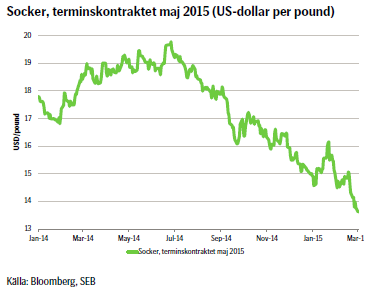 Priset på socker har under förra veckan fortsatt att falla kraftigt, vilket fick Maj15-kontraktet att bryta igenom 14 US cent och därmed notera en ny lägsta nivå. Säljtrycket verkar vara tekniskt baserat för att dra nytta av ett svagt momentum, där den ena försäljningen triggar den andra vartefter priserna sjunker. Fallet i den brasilianska valutan real har också varit en bidragande faktor liksom den senaste rapporten från International Sugar Organization (IS0) som visar att den globala produktionen av socker förväntas nå rekordhöga 172,1 miljoner ton under 2014/15 – detta trots prognoser om lägre skördar i flera ledande producentländer, däribland Brasilien, Kina och Thailand.
Priset på socker har under förra veckan fortsatt att falla kraftigt, vilket fick Maj15-kontraktet att bryta igenom 14 US cent och därmed notera en ny lägsta nivå. Säljtrycket verkar vara tekniskt baserat för att dra nytta av ett svagt momentum, där den ena försäljningen triggar den andra vartefter priserna sjunker. Fallet i den brasilianska valutan real har också varit en bidragande faktor liksom den senaste rapporten från International Sugar Organization (IS0) som visar att den globala produktionen av socker förväntas nå rekordhöga 172,1 miljoner ton under 2014/15 – detta trots prognoser om lägre skördar i flera ledande producentländer, däribland Brasilien, Kina och Thailand.
TREND
- Slutsatsen som vi drar är att det för närvarande inte finns tillräckligt med fysiska köpintressen för att ge stöd åt marknaden – vilket signalerar att konsumenter bara är villiga att köpa mer på ”billiga nivåer”. Så länge motståndet på 14 US cent håller så föredrar vi en kort position.
REKOMMENDATION
- Neutral/kort
EL
Sedan vår senaste kommentar om el för två veckor sedan har marknaden fortsatt att utvecklas ungefär som förväntat. SEB rullar nu från den innevarande Q215-terminen till Q315-terminen.
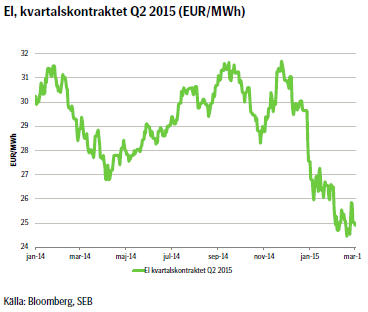 Det är svårt att med nuvarande fundamentala situation se att vi varaktigt ska bryta vad som snarast är ett dödläge vad gäller prisutvecklingen på el. Trots att priset rör sig inom ett väl definierat intervall bjöd dock förra veckan på ett imponerande rally som så småningom reverserades till dito baisse. I skrivande stund handlas Q215-terminen strax över 25 euro per MWh, vilket är i den nedre delen av det intervall som kontraktet har rört sig i sedan årsskiftet. Vi tror att botten sannolikt är nådd i den längre nedåtgående trenden, även om det säkert kommer att fortsatt finnas ett visst nedåttryck.
Det är svårt att med nuvarande fundamentala situation se att vi varaktigt ska bryta vad som snarast är ett dödläge vad gäller prisutvecklingen på el. Trots att priset rör sig inom ett väl definierat intervall bjöd dock förra veckan på ett imponerande rally som så småningom reverserades till dito baisse. I skrivande stund handlas Q215-terminen strax över 25 euro per MWh, vilket är i den nedre delen av det intervall som kontraktet har rört sig i sedan årsskiftet. Vi tror att botten sannolikt är nådd i den längre nedåtgående trenden, även om det säkert kommer att fortsatt finnas ett visst nedåttryck.
För en aktiv investerare som dagligen följer marknaden kan det vara intressant att handla inom det aktuella intervallet då rörelserna trots allt procentuellt sett kan vara stora under kort tid, men någon rekommendation inom ramen för detta marknadsbrevs tidsperspektiv är svårare att ge. För en investerare som redan har gjort en god vinst på nedåttrenden kan det vara värt att avvakta och se om en ytterligare nedgång i priset sker, men för en trendföljande investerare är det nog klokt att vänta på att intervallet bryts.
TREND
- Priset på el rör sig inom väldefinierat intervall
- Korta rörelser kan ge möjligheter för aktiva investerare
REKOMMENDATION
- Neutral
[box]SEB Veckobrev Veckans råvarukommentar är producerat av SEB:s Commodities Sales desk och publiceras i samarbete och med tillstånd på Råvarumarknaden.se[/box]
KÄLLOR
Bloomberg, Reuters, SEB
VILLKOR
För varje enskilt certifikat/mini future finns Slutliga Villkor som anger de fullständiga villkoren. Slutliga Villkor finns tillgängligt på kurssidan för respektive certifikat/mini future på www.seb.se, Börs & finans, fliken Strukturerade placeringar.
RISKER
En sammanfattning av de risker som är förknippade med Börshandlade certifikat generellt finns i Produktbroschyren för respektive certifikat eller mini future som är tillgängligt på seb.se/cert respektive seb.se/mini. För en fullständig bild av riskerna behöver du ta del av SEB:s offentliggjorda Grundprospekt för Certifikat- och Warrantprogram som är publicerat på www.seb.se/cert respektive seb.se/mini.
DISCLAIMER
Detta marknadsföringsmaterial, framtaget av SEB:s Commodities Sales desk, har upprättats enbart i informationssyfte.
Även om innehållet är baserat på källor som SEB bedömt som tillförlitliga ansvarar SEB inte för fel eller brister i informationen. Den utgör inte oberoende, objektiv investeringsanalys och skyddas därför inte av de bestämmelser som SEB har infört för att förebygga potentiella intressekonflikter. Yttranden från SEB:s Commodities Sales desk kan vara oförenliga med tidigare publicerat material från SEB, då den senare hänvisas uppmanas du att läsa den fullständiga rapporten innan någon åtgärd vidtas.
Dokumentationen utgör inte någon investeringsrådgivning och tillhandahålls till dig utan hänsyn till dina investeringsmål. Du uppmanas att självständigt bedöma och komplettera uppgifterna i denna dokumentation och att basera dina investeringsbeslut på material som bedöms erforderligt. Alla framåtblickande uttalanden, åsikter och förväntningar är föremål för risker, osäkerheter och andra faktorer och kan orsaka att det faktiska resultatet avviker väsentligt från det förväntade. Historisk avkastning är ingen garanti för framtida resultat. Detta dokument utgör inte ett erbjudande att teckna några värdepapper eller andra finansiella instrument. SEB svarar inte för förlust eller skada – direkt eller indirekt, eller av vad slag det vara må – som kan uppkomma till följd av användandet av detta material eller dess innehåll.
Observera att det kan förekomma att SEB, dess ledamöter, dess anställda eller dess moder- och/eller dotterbolag vid olika tillfällen innehar, har innehaft eller kommer att inneha aktier, positioner, rådgivningsuppdrag i samband med corporate finance-transaktioner, investment- eller merchantbanking-uppdrag och/eller lån i de bolag/finansiella instrument som nämns i materialet.
Materialet är avsett för mottagaren, all spridning, distribuering mångfaldigande eller annan användning av detta meddelande får inte ske utan SEB:s medgivande. Materialet riktar sig inte till personer vars medverkan kräver ytterligare prospekt, registrerings- eller andra åtgärder än vad som följer av svensk rätt. Det åligger var och en att iaktta sådana restriktioner. Materialet får inte distribueras i eller till land där distribution kräver ovan nämnda åtgärder eller strider mot reglering i sådant land. Materialet riktar sig således inte till fysiska eller juridiska personer hemmahörande i USA eller i något annat land där publicering eller tillhandahållande av materialet är förbjudet eller strider mot tillämpliga bestämmelser i landet.
Oaktat detta får SEB tillåta omfördelning av materialet till utvald tredje part i enlighet med gällande avtal. Materialet får inte spridas till fysiska eller juridiska personer som är medborgare eller har hemvist i ett land där sådan spridning är otillåten enligt tillämplig lag eller annan bestämmelse.
Skandinaviska Enskilda Banken AB (publ) är ett publikt aktiebolag och står under tillsyn av Finansinspektionen samt de lokala finansiella tillsynsmyndigheter i varje jurisdiktionen där SEB har filial eller dotterbolag.
Analys
Tightening fundamentals – bullish inventories from DOE

The latest weekly report from the US DOE showed a substantial drawdown across key petroleum categories, adding more upside potential to the fundamental picture.

Commercial crude inventories (excl. SPR) fell by 5.8 million barrels, bringing total inventories down to 415.1 million barrels. Now sitting 11% below the five-year seasonal norm and placed in the lowest 2015-2022 range (see picture below).
Product inventories also tightened further last week. Gasoline inventories declined by 2.1 million barrels, with reductions seen in both finished gasoline and blending components. Current gasoline levels are about 3% below the five-year average for this time of year.
Among products, the most notable move came in diesel, where inventories dropped by almost 4.1 million barrels, deepening the deficit to around 20% below seasonal norms – continuing to underscore the persistent supply tightness in diesel markets.
The only area of inventory growth was in propane/propylene, which posted a significant 5.1-million-barrel build and now stands 9% above the five-year average.
Total commercial petroleum inventories (crude plus refined products) declined by 4.2 million barrels on the week, reinforcing the overall tightening of US crude and products.


Analys
Bombs to ”ceasefire” in hours – Brent below $70

A classic case of “buy the rumor, sell the news” played out in oil markets, as Brent crude has dropped sharply – down nearly USD 10 per barrel since yesterday evening – following Iran’s retaliatory strike on a U.S. air base in Qatar. The immediate reaction was: “That was it?” The strike followed a carefully calibrated, non-escalatory playbook, avoiding direct threats to energy infrastructure or disruption of shipping through the Strait of Hormuz – thus calming worst-case fears.

After Monday morning’s sharp spike to USD 81.4 per barrel, triggered by the U.S. bombing of Iranian nuclear facilities, oil prices drifted sideways in anticipation of a potential Iranian response. That response came with advance warning and caused limited physical damage. Early this morning, both the U.S. President and Iranian state media announced a ceasefire, effectively placing a lid on the immediate conflict risk – at least for now.
As a result, Brent crude has now fallen by a total of USD 12 from Monday’s peak, currently trading around USD 69 per barrel.
Looking beyond geopolitics, the market will now shift its focus to the upcoming OPEC+ meeting in early July. Saudi Arabia’s decision to increase output earlier this year – despite falling prices – has drawn renewed attention considering recent developments. Some suggest this was a response to U.S. pressure to offset potential Iranian supply losses.
However, consensus is that the move was driven more by internal OPEC+ dynamics. After years of curbing production to support prices, Riyadh had grown frustrated with quota-busting by several members (notably Kazakhstan). With Saudi Arabia cutting up to 2 million barrels per day – roughly 2% of global supply – returns were diminishing, and the risk of losing market share was rising. The production increase is widely seen as an effort to reassert leadership and restore discipline within the group.
That said, the FT recently stated that, the Saudis remain wary of past missteps. In 2018, Riyadh ramped up output at Trump’s request ahead of Iran sanctions, only to see prices collapse when the U.S. granted broad waivers – triggering oversupply. Officials have reportedly made it clear they don’t intend to repeat that mistake.
The recent visit by President Trump to Saudi Arabia, which included agreements on AI, defense, and nuclear cooperation, suggests a broader strategic alignment. This has fueled speculation about a quiet “pump-for-politics” deal behind recent production moves.
Looking ahead, oil prices have now retraced the entire rally sparked by the June 13 Israel–Iran escalation. This retreat provides more political and policy space for both the U.S. and Saudi Arabia. Specifically, it makes it easier for Riyadh to scale back its three recent production hikes of 411,000 barrels each, potentially returning to more moderate increases of 137,000 barrels for August and September.
In short: with no major loss of Iranian supply to the market, OPEC+ – led by Saudi Arabia – no longer needs to compensate for a disruption that hasn’t materialized, especially not to please the U.S. at the cost of its own market strategy. As the Saudis themselves have signaled, they are unlikely to repeat previous mistakes.
Conclusion: With Brent now in the high USD 60s, buying oil looks fundamentally justified. The geopolitical premium has deflated, but tensions between Israel and Iran remain unresolved – and the risk of missteps and renewed escalation still lingers. In fact, even this morning, reports have emerged of renewed missile fire despite the declared “truce.” The path forward may be calmer – but it is far from stable.
Analys
A muted price reaction. Market looks relaxed, but it is still on edge waiting for what Iran will do

Brent crossed the 80-line this morning but quickly fell back assigning limited probability for Iran choosing to close the Strait of Hormuz. Brent traded in a range of USD 70.56 – 79.04/b last week as the market fluctuated between ”Iran wants a deal” and ”US is about to attack Iran”. At the end of the week though, Donald Trump managed to convince markets (and probably also Iran) that he would make a decision within two weeks. I.e. no imminent attack. Previously when when he has talked about ”making a decision within two weeks” he has often ended up doing nothing in the end. The oil market relaxed as a result and the week ended at USD 77.01/b which is just USD 6/b above the year to date average of USD 71/b.

Brent jumped to USD 81.4/b this morning, the highest since mid-January, but then quickly fell back to a current price of USD 78.2/b which is only up 1.5% versus the close on Friday. As such the market is pricing a fairly low probability that Iran will actually close the Strait of Hormuz. Probably because it will hurt Iranian oil exports as well as the global oil market.
It was however all smoke and mirrors. Deception. The US attacked Iran on Saturday. The attack involved 125 warplanes, submarines and surface warships and 14 bunker buster bombs were dropped on Iranian nuclear sites including Fordow, Natanz and Isfahan. In response the Iranian Parliament voted in support of closing the Strait of Hormuz where some 17 mb of crude and products is transported to the global market every day plus significant volumes of LNG. This is however merely an advise to the Supreme leader Ayatollah Ali Khamenei and the Supreme National Security Council which sits with the final and actual decision.
No supply of oil is lost yet. It is about the risk of Iran closing the Strait of Hormuz or not. So far not a single drop of oil supply has been lost to the global market. The price at the moment is all about the assessed risk of loss of supply. Will Iran choose to choke of the Strait of Hormuz or not? That is the big question. It would be painful for US consumers, for Donald Trump’s voter base, for the global economy but also for Iran and its population which relies on oil exports and income from selling oil out of that Strait as well. As such it is not a no-brainer choice for Iran to close the Strait for oil exports. And looking at the il price this morning it is clear that the oil market doesn’t assign a very high probability of it happening. It is however probably well within the capability of Iran to close the Strait off with rockets, mines, air-drones and possibly sea-drones. Just look at how Ukraine has been able to control and damage the Russian Black Sea fleet.
What to do about the highly enriched uranium which has gone missing? While the US and Israel can celebrate their destruction of Iranian nuclear facilities they are also scratching their heads over what to do with the lost Iranian nuclear material. Iran had 408 kg of highly enriched uranium (IAEA). Almost weapons grade. Enough for some 10 nuclear warheads. It seems to have been transported out of Fordow before the attack this weekend.
The market is still on edge. USD 80-something/b seems sensible while we wait. The oil market reaction to this weekend’s events is very muted so far. The market is still on edge awaiting what Iran will do. Because Iran will do something. But what and when? An oil price of 80-something seems like a sensible level until something do happen.
-

 Nyheter3 veckor sedan
Nyheter3 veckor sedanStor uppsida i Lappland Guldprospekterings aktie enligt analys
-

 Nyheter4 veckor sedan
Nyheter4 veckor sedanBrookfield ska bygga ett AI-datacenter på hela 750 MW i Strängnäs
-

 Nyheter4 veckor sedan
Nyheter4 veckor sedanSommaren inleds med sol och varierande elpriser
-

 Nyheter4 veckor sedan
Nyheter4 veckor sedanOPEC+ ökar oljeproduktionen trots fallande priser
-

 Nyheter3 veckor sedan
Nyheter3 veckor sedanSilverpriset släpar efter guldets utveckling, har mer uppsida
-

 Analys4 veckor sedan
Analys4 veckor sedanBrent needs to fall to USD 58/b to make cheating unprofitable for Kazakhstan
-

 Nyheter4 veckor sedan
Nyheter4 veckor sedanTradingfirman XTX Markets bygger datacenter i finska Kajana för 1 miljard euro
-

 Nyheter2 veckor sedan
Nyheter2 veckor sedanUppgången i oljepriset planade ut under helgen



